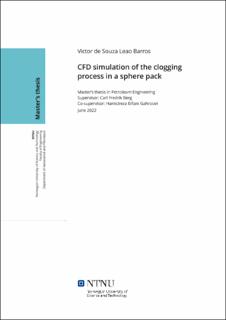| dc.contributor.advisor | Carl Fredrik Berg | |
| dc.contributor.advisor | Hamidreza Erfani Gahrooei | |
| dc.contributor.author | Victor de Souza Leão Barros | |
| dc.date.accessioned | 2022-10-07T17:33:19Z | |
| dc.date.available | 2022-10-07T17:33:19Z | |
| dc.date.issued | 2022 | |
| dc.identifier | no.ntnu:inspera:114319534:68218017 | |
| dc.identifier.uri | https://hdl.handle.net/11250/3024764 | |
| dc.description.abstract | Fenomenet med borevæske som slipper ut fra brønnen og inn i formasjonen under boring av en oljebrønn er kjent som tapt sirkulasjon (lost circulation). Ved siden av økonomiske tap på grunn av tapt tid ved boring, er det også mulighet for å skade formasjonen. En potensiell løsning for å hindre tap av borevæske er å tilsette partikler til borevæsken, kjent som Lost Circulation Materials (LCM). Disse kan tette brudd og permeable soner. I denne oppgaven er formasjonen forenklet til en kule-pakke. Den numeriske simuleringen utføres med en Dense Discrete Phase Model (DDPM), som løser væskestrøm ligningene og partikkel-væskeinteraksjonene, koblet til en Discrete Element Method (DEM), som løser partikkel interaskjoner; kontakter mellom partikler og mellom partikler og pore-vegger. Karakteriseringen av væske-partikkel strømmen oppnås ved å variere trykkforskjellen over modellen. Væskehastighet, partikkelmassestrøm, permeabilitet og volumetrisk strømningshastighet på væsken overvåkes under tilstoppingsprosessen. Økningen i trykkforskjellen på innløpsoverflaten resulterer i en høyere væskehastighet ved innløpsoverflaten og en høyere massehastighet for faste partikler. Det reduserer også den volumetriske strømningshastigheten ved utløpet, noe som resulterer i en mer effektiv tetting av det porøse mediet. | |
| dc.description.abstract | During the drilling of an oil well, the phenomenon of drilling fluid escaping from the annular region into the formation is known as lost circulation. Besides the financial and time losses due to mitigation procedures, there is also the possibility of damaging the formation. A potential solution to the lost circulation problem is adding solid particles to the drilling fluid, known as Lost Circulation Materials (LCM). These particles can seal fractures and highly permeable zones. In this work, the rock formation is simplified to a spheres pack. The numerical simulation is performed via the Dense Discrete Phase Model (DDPM), which solves the fluid flow equations and the particle-fluid interactions, coupled to the Discrete Element Method (DEM), which solves the interaction between particles and between particles and walls. Characterization of the liquid-solid flow is obtained by varying the pressure difference in the numerical domain. Fluid velocity, solid particle flow rate, and normalized fluid flow rate are monitored throughout the clogging process. The effectiveness of changing some parameters is studied in this work. Increasing particle diameters shows to be a good solution to reduce fluid loss. The variation in particle-fluid density ratio on the other hand presented little change in the final fluid flow rate. Injecting particles of different sizes can be effective if all particles are larger that the pore throat. The increase in the pressure difference on the domain results in a lower fluid flow rate, but also in fewer particles trapped in the porous medium. | |
| dc.language | eng | |
| dc.publisher | NTNU | |
| dc.title | CFD simulation of the clogging process in a sphere pack | |
| dc.type | Master thesis | |
